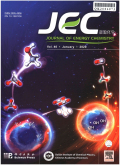- 钛学术文献服务平台 \
- 学术期刊 \
- 工业技术期刊 \
- 石油与天然气工业期刊 \
- 能源化学期刊 \
Methylammonium-and bromide-free perovskites enable efficient and stable photovoltaics
Methylammonium-and bromide-free perovskites enable efficient and stable photovoltaics
基本信息来源于合作网站,原文需代理用户跳转至来源网站获取
摘要:
Hybrid perovskite solar cell (PSC) has attracted extensive research interest due to its rapid increase in efficiency,regarding as one of the most promising candidates for the next-generation photovoltaic tech-nology.The certified power conversion efficiency of the devices based on formamidinium lead iodide(FAPbI3) perovskite has reached 25.5%,approaching the record of monocrystalline silicon solar cells.Unfortunately,the black α-phase FAPbI3 materials can spontaneously transform to non-optically active δ-phase at room temperature,which greatly hinder their photovoltaic application.In order to overcome this problem,various strategies,especially introducing methylammonium (MA+),caesium (Cs+) and bro-mide (Br-) ions into the materials,have been widely adopted.However,MA+ can largely reduce the ther-mal stability of the materials.Furthermore,the introduction of Br can enlarge the materials' bandgap,resulting in a reduced theoretical efficiency.Keeping these in mind,developing the strategies which without using MA+ and Br-is the inevitable trend.Here,we focus on the recent progresses of stabilizing α FAPbI3 without employing MA+ and Br,and discuss the advantages of inorganic ions doping and dimensionality engineering to stabilized α FAPbI3.Meanwhile,in order to deeply understand the rela-tionship between the semiconducting properties and device performance of the corresponding materials,we then summarize several significant strategies to suppress the non-radiation recombination,such as interface modification and trap passivation.Finally,we propose to develop more effective 'A-site'alter-natives to stabilize αFAPbI3,which is expected to achieve high-efficient PSCs with long-term stability,facilitating its commercialization process.

推荐文章
电信产品运营管理的ENABLE模型和应用探讨
产品运营
ENABLE
用户口碑
用户预期
众创
众包
有效实施Free talk 学生远离哑巴英语
Free talk
哑巴英语
教学
Statistics matters in interpretations of non-traditional stable isotopic data
Isotopic data processing
Error propagation
Significant digits
Difference between means with uncertainties
STABLE救护模式在危重新生儿转运护理中的应用
STABLE
新生儿
转运
内容分析
关键词云
关键词热度
相关文献总数
(/次)
(/年)
引文网络
引文网络
二级参考文献 (0)
共引文献 (0)
参考文献 (0)
节点文献
引证文献 (0)
同被引文献 (0)
二级引证文献 (0)
2021(0)
- 参考文献(0)
- 二级参考文献(0)
- 引证文献(0)
- 二级引证文献(0)
引文网络交叉学科
相关学者/机构
期刊影响力
能源化学
主办单位:
中国科学院大连化学物理研究所
中国科学院成都有机化学研究所
出版周期:
双月刊
ISSN:
2095-4956
CN:
10-1287/O6
开本:
出版地:
大连市中山路457号
邮发代号:
创刊时间:
语种:
eng
出版文献量(篇)
2804
总下载数(次)
0
总被引数(次)
7996
期刊文献
相关文献
推荐文献
- 期刊分类
- 期刊(年)
- 期刊(期)
- 期刊推荐
一般工业技术
交通运输
军事科技
冶金工业
动力工程
化学工业
原子能技术
大学学报
建筑科学
无线电电子学与电信技术
机械与仪表工业
水利工程
环境科学与安全科学
电工技术
石油与天然气工业
矿业工程
自动化技术与计算机技术
航空航天
轻工业与手工业
金属学与金属工艺
能源化学2022
能源化学2021
能源化学2020
能源化学2019
能源化学2018
能源化学2017
能源化学2016
能源化学2015
能源化学2014
能源化学2013
能源化学2012
能源化学2011
能源化学2010
能源化学2009
能源化学2008
能源化学2007
能源化学2006
能源化学2005
能源化学2004
能源化学2003
能源化学2002
能源化学2001
能源化学2021年第9期
能源化学2021年第8期
能源化学2021年第7期
能源化学2021年第6期
能源化学2021年第5期
能源化学2021年第4期
能源化学2021年第3期
能源化学2021年第2期
能源化学2021年第12期
能源化学2021年第1期

 免费查重
免费查重










